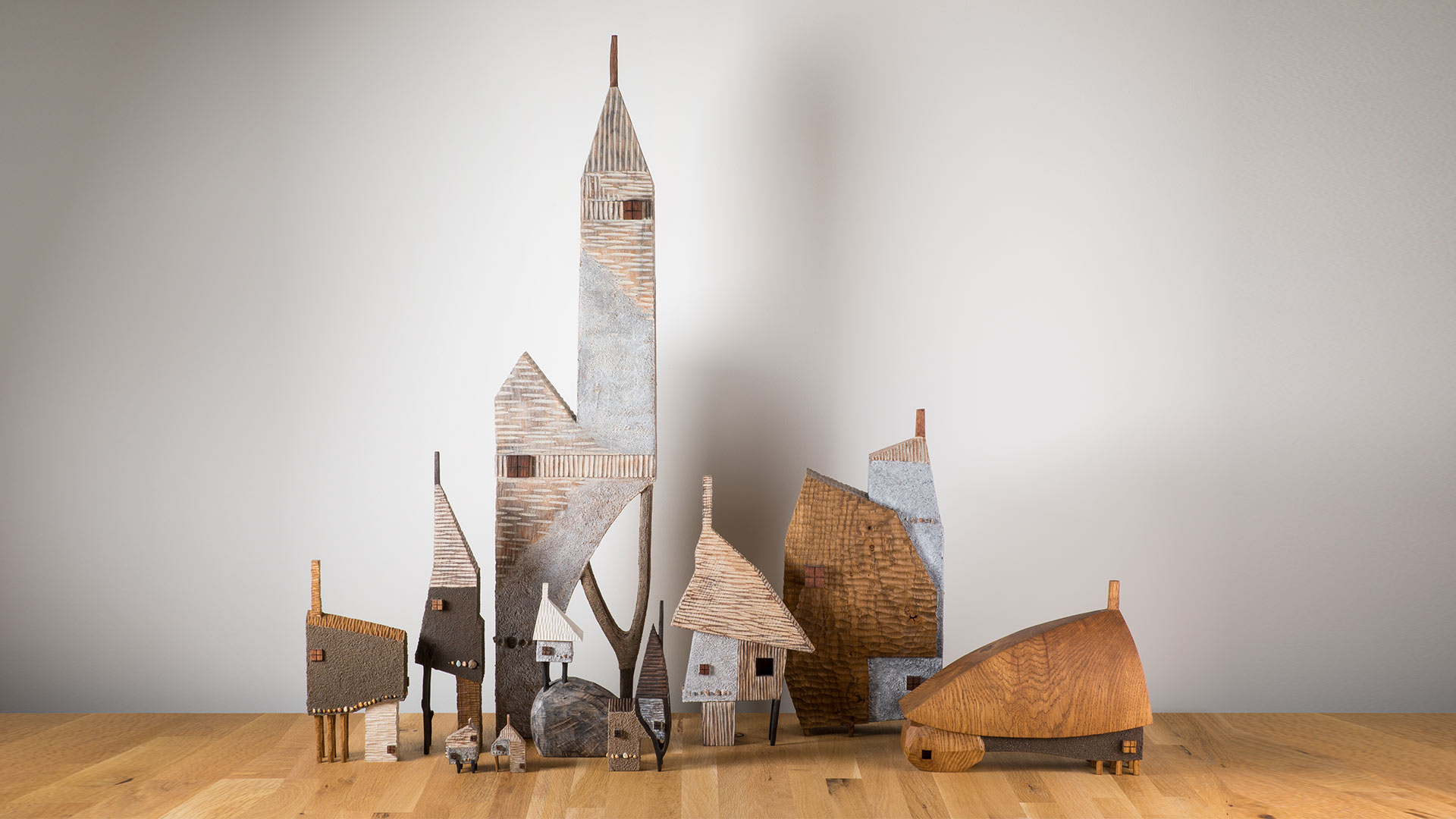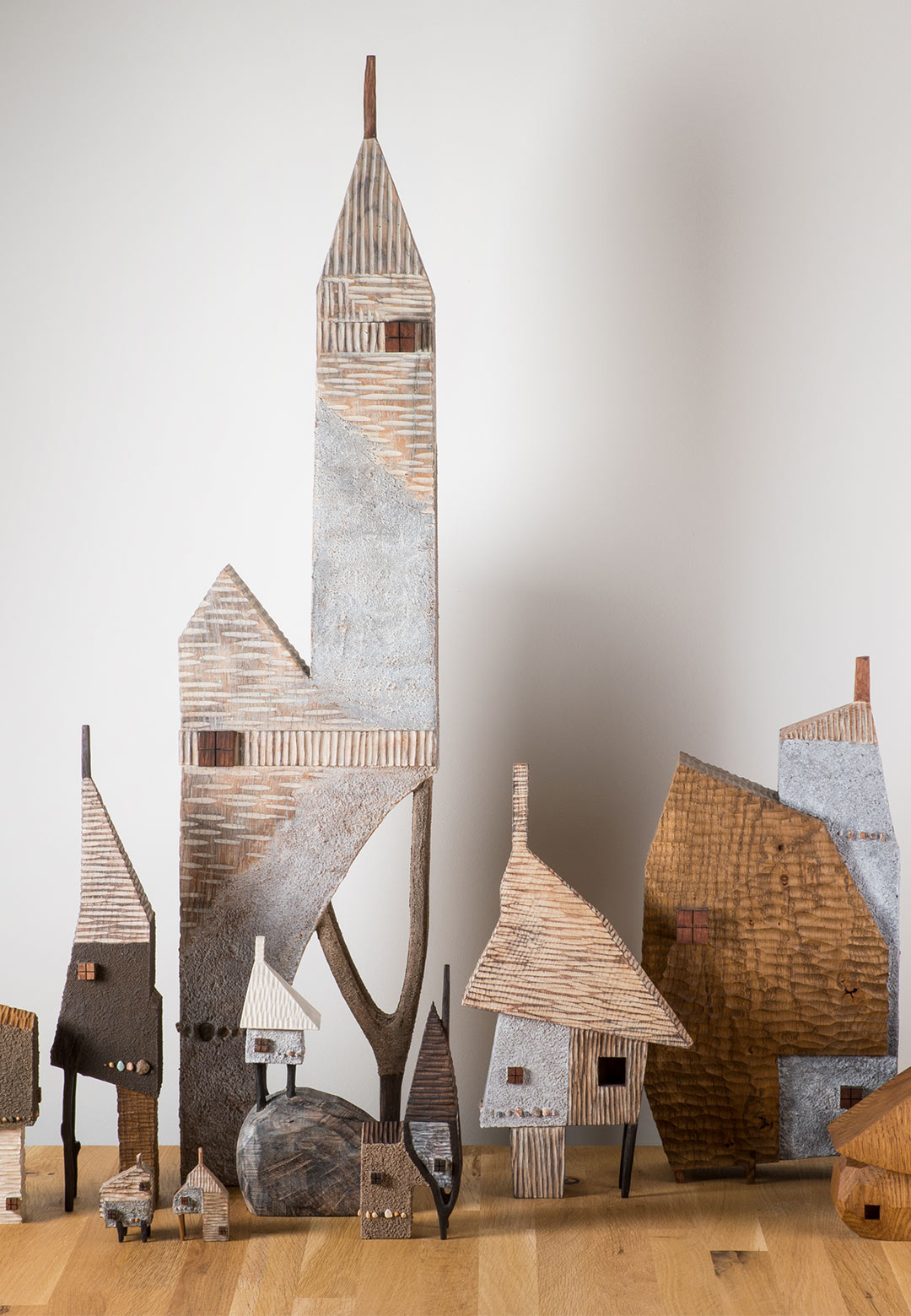The silhouette of a crooked cottage in the dark–small windows with a dim light shining through, a chimney, shingled roofs, a colourful door–beckon you, the lone traveller. A house removed from mundane reality, almost like it were part of some fairytale, discovered while walking forlorn in a deep forest. Perhaps a fairy lives there, or a witch who eats little children who get lost. Such fancies are called to mind when looking at wooden sculptures of houses by Yukihiro Akama, a UK-based Japanese designer. Small and squat, tall and thin, the wooden designs by Akama are like houses in fairytales–never just a house, but a container of secrets and dreams– transfixing anyone who sees them. Each invokes a particular sense of a setting in the countryside, a bucolic existence, a life amidst nature.
The whimsical sculptural designs are currently on view at Yorkshire Sculpture Park (YSP), as part of Akama’s second solo exhibition, Basho no Kankaku – A Sense of Place, featuring 55 of the works. Carving each sculpture from a single piece of wood that takes him anywhere between three hours and three days to complete, Akama draws on his experience as a joiner for the artefacts. Tall structures, small houses on stilts, crooked roofs, roofs larger than the structure of the house, houses with zero openings, houses with one miniscule window right at the top, these bricolage designs range from just 4cm up to 106 cm and are displayed in the exhibition space alongside architectural technical drawings and mini prints by the designer. Talking about his practice, Akama elaborates, “I have always loved woodworking as a hobby, both when I used to design architecture and when I was a lumberjack for a while, but it wasn't until I came to the UK and was invited to do a solo exhibition in 2013 that I started making my current carving pieces. Wood has always been a part of my life.”
The rustic wooden designs that the Japanese sculptor creates as part of this practice were commissioned by YSP Centre for the showcase and will be on view till June 30, 2024. The wood for the houses is coloured using iron acetate solution, which is painted onto it to create a beautiful ebonised finish. Describing his fascination with traditional houses, Akama goes on, “Since I was studying architecture, I have always liked traditional and primitive houses and huts/sheds that you can find anywhere, and I can only design things like that. I can be inspired by Asian houses, old Western buildings and anything else that is not a building.” The inspiration for each of the designs is varied but mostly draws on Japanese temples and shrines, particularly Jomon-era ruins.
Often, the shape of the wood that Akama starts working on dictates the designs, with the knots or grain guiding where each sculpture is carved. Slowly, from these, a house emerges, almost like it’s materialising out of thin air, just as you turn your gaze, then disappearing in the blink of an eye. The architecture of fairytales seems to rise from the earth, part of nature itself, a thing that is alive, and not just a container of space. Moreover, fairytales more often than not talk about the dangers of nature or a reckoning with wilderness, like the big bad wolf hiding in the bushes. In that sense, these whimsical houses–with their branch-like stilts and pebbled bricks–that follow the grain of the wood are unruly in their design.
The plastered clay and pebble details add to this overall effect, adding a sense of transience to the designs, a sense of the precariousness of man-made structures in the face of nature. Further, so many of the houses feel like they’re part of a set from a Studio Ghibli movie, that you expect soot monsters to spill out from some unlikely window. A major theme for most Ghibli has always been this struggle for co-existence between advancing technology and the natural worlds, which the sculptures try to highlight as stated before. The title of the showcase is also telling in the same way, A Sense of Place which could be seen as a reference to Japanese architectural philosophy of creating harmony between built and unbuilt.
In that sense, the houses tread the line between reality and make-believe. Talking about his design process, Akama says, “Sometimes I draw a sketch on paper and then copy it into the wood, sometimes I do a design sketch directly on the wood, these days more often directly on the wood. Then I cut it into rough shapes with a band saw and start carving with a carving knife. Finally, clay and colour are applied.” Akama has always been an advocate for the quiet life, as the press release informs. Even in moving to the UK, he has sought a pastoral existence, settling in Yorkshire for its landscape and natural surroundings. This love for the rural, the scenic, and the almost utopian is foregrounded through the wood sculptures he creates.






 Sign in with email
Sign in with email










What do you think?